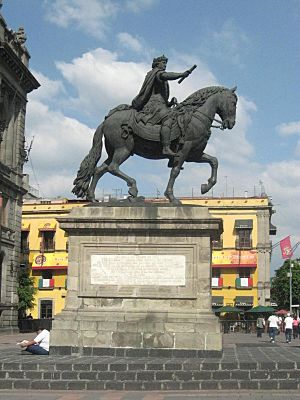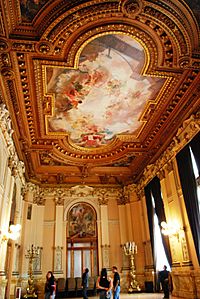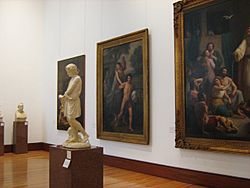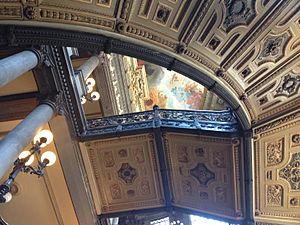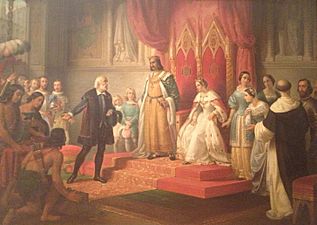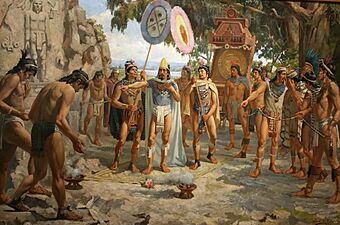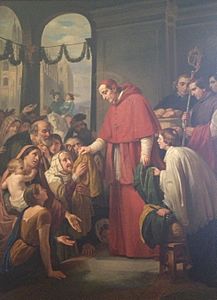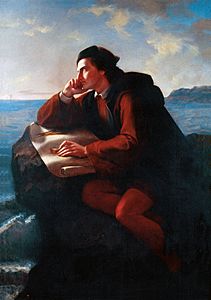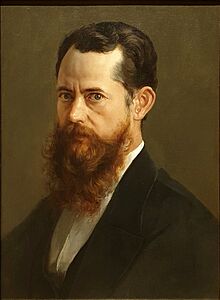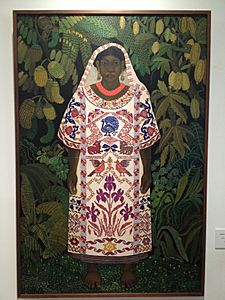Museo Nacional de Arte facts for kids
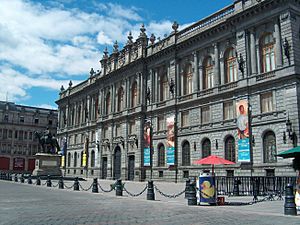
Museo Nacional de Arte
|
|
| Location | Historical center of Mexico City |
|---|---|
The National Museum of Art, also known as MUNAL, is Mexico's national art museum. You can find it in the historic center of Mexico City. It's inside a beautiful old building at No. 8 Tacuba.
MUNAL has a huge collection of Mexican art. It shows art from the mid-1500s all the way to the mid-1900s. Outside the museum, you'll see a large statue of Charles IV of Spain on a horse. This statue was made by Manuel Tolsá. It was moved to this spot in 1979 to protect it as a piece of art.
Contents
About the Museum
The museum first opened in 1982 as the Museo Nacional de Arte. It was then updated and reopened in 2000 as MUNAL. Today, it focuses on showing, studying, and sharing Mexican and international art. This art dates from the 16th century to the first half of the 20th century.
MUNAL's permanent collection has over 3,000 artworks. It has 5,500 square meters of space for showing art. The museum is part of the National Institute of Fine Arts. This means it helps save, show, and study Mexico's fine arts. MUNAL also offers workshops, talks, and books for the public. You can even volunteer with groups like Voluntariado and Amigos de MUNAL.
The Museum Building
MUNAL is located in what used to be the Palace of Communications. In the early 1900s, the government hired an Italian architect named Silvio Contri. He designed this "palace" to be the home of the Secretariat of Communications and Public Works. The goal was to show that Mexico was becoming modern.
The Palace was built where two hospitals used to be. Its design mixes different old architectural styles. This mix of styles was common at that time. It later became known as "modernismo." This style used new building methods and metal decorations. Metal showed the progress of the Industrial Revolution.
The Coppedé family from Florence created many of the building's decorations. They designed the door knockers, window frames, and even the furniture. Over the years, parts of the Palace wore down. Around 2000, Project MUNAL restored the building. They made it look like new and added modern technology to protect the art.
Special Rooms to Explore
Two special rooms in the museum are the Reception Hall and the Patio de los Leones. The Reception Hall is on the second floor. It was designed to look as grand as fancy halls in Europe. It has many decorations made of precious metal and crystal. There are also murals that show ideas like science, art, and progress.
This hall was a favorite place for President Porfirio Díaz. He used to make important announcements here and welcome visitors from other countries. The Patio de los Leones also mixes different building styles. You can see Classic and Gothic styles, along with sculptures and special lighting. In the middle of this patio is a large staircase leading upstairs.
Later in the 20th century, the building was used by the National General Archive. Then, in 1982, it became the National Museum of Art. The plaza in front of the building is named after Manuel Tolsá. He created the statue of Carlos IV, also known as El Caballito, that stands there. Today, most of the building holds MUNAL's art collection. The Reception Hall and Patio de los Leones are used for events like concerts and book signings.
The Art Collection
The museum's permanent collection shows how fine arts developed in Mexico. It covers art from the early colonial period to the mid-20th century. The artworks are divided into three main time periods.
Colonial Period Art (1550-1821)
The first period covers colonial art from 1550 to 1821. This collection is called "Assimilation of the West." You can find it in Salons 1-14 on the second floor. These artworks show how Western painting styles came to Mexico. They also show how Mexico started its own art school, the Academy of San Carlos. This was the first art academy in the Americas.
Art After Independence (1810-1910)
The second period covers the first century after Mexico gained independence (1810-1910). This collection is called "Construction of a Nation." It is in Salons 19-26 on the second floor. Many paintings from this time show Mexican customs and landscapes. They helped define what it meant to be Mexican.
Modern Mexican Art (After the Revolution)
The last period is called "Strategies for the Fine Arts in Modern Mexico." It is in Salons 27-33 on the first floor. This art was made after the Mexican Revolution. Artists explored ideas about being modern and national identity. This period also saw the rise of the Mexican muralist movement.
Some of the museum's rooms are used for temporary exhibitions. These might feature paintings by artists like Pedro Gualdi or photography by Carlos Monsivais.
Gallery
-
Cristobal Colon en la corte de los Reyes Catolicos by Juan Cordero.
-
MalgreToutDF.JPG
Malgré Tout by Jesús Fructuoso Contreras.
-
San Carlos Borromeo Repartiendo Limosna al Pueblo by Jose Salome Pina.
-
Inspiracion de Cristobal Colon by Jose Maria Obregon.
-
The Viceroy Duque de Linares by Juan Rodriguez Juarez.
-
Self portrait of José María Velasco Gómez
-
15-07-21-Mexico-Stadtzentrum-RalfR-N3S 9631.jpg
Un Pescador
-
15-07-21-Mexico-Stadtzentrum-RalfR-N3S 9633.jpg
Dolor
-
15-07-21-Mexico-Stadtzentrum-RalfR-N3S 9632.jpg
Ariadna abandonada
See also
 In Spanish: Museo Nacional de Arte (México) para niños
In Spanish: Museo Nacional de Arte (México) para niños



